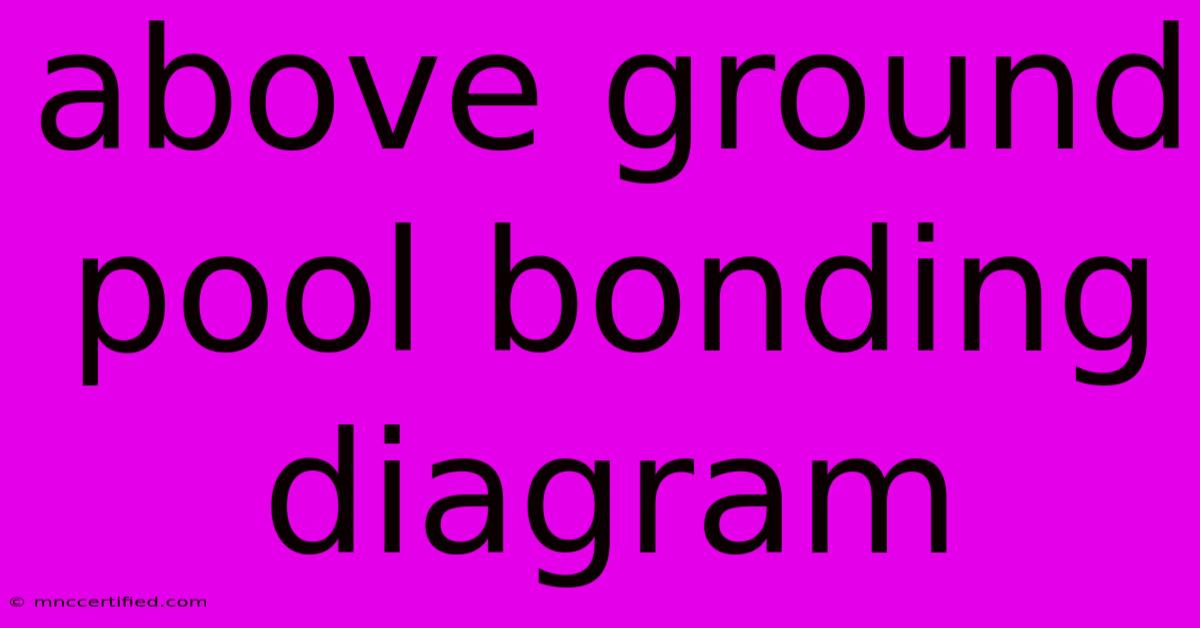Above Ground Pool Bonding Diagram

Table of Contents
Above Ground Pool Bonding Diagram: Ensuring Safety and Compliance
Above ground pools offer refreshing fun, but safety should always be the top priority. A critical aspect of pool safety is proper electrical bonding. This article will guide you through understanding above ground pool bonding diagrams, explaining their importance and how to ensure your pool meets all necessary safety regulations. We'll cover everything from the basics of bonding to troubleshooting potential issues.
Why is Pool Bonding Important?
Electrical bonding in an above ground pool is crucial for preventing dangerous electric shock hazards. It creates a pathway for stray electrical currents, preventing them from accumulating on metallic parts of the pool structure. These stray currents can originate from various sources, including:
- Underground power lines: Faults in underground cables can send stray voltage into the ground, potentially reaching the pool structure.
- Submersible pumps: Malfunctioning pumps can leak current into the water.
- Lighting fixtures: Defective pool lighting can introduce dangerous voltages.
Without proper bonding, these stray currents can cause a potentially fatal electric shock to anyone touching the pool's metal components – the ladder, rails, coping, or even the water itself.
Understanding the Above Ground Pool Bonding Diagram
A bonding diagram visually represents the electrical connections necessary to create a safe and grounded pool environment. It details how all metallic components within the pool's perimeter are interconnected to form a unified electrical system. This system is then connected to the earth ground, providing a safe escape route for any stray electrical current. A typical diagram will include:
- Bonding Wire: Thick, usually copper, wire used to connect all metallic parts. The size of the wire is crucial and is determined by relevant electrical codes.
- Bonding Lugs: Clamps used to securely connect the bonding wire to metallic components.
- Grounding Rod: A metal rod driven into the earth, providing a connection to the ground.
- Main Electrical Panel: The central point where all electrical circuits in the house are connected and grounded.
- Pool Equipment: Pumps, filters, heaters, and lighting are all bonded to the main bonding system.
Key Components Illustrated in a Diagram:
- Pool Shell: The metal parts of the pool structure itself.
- Ladder: Metal ladders are essential bonding points.
- Handrails: Metal handrails need to be securely bonded.
- Electrical Equipment Enclosures: All electrical equipment needs its own ground connection, which then bonds into the main system.
- Water Pipes: Metal water pipes near the pool should also be bonded.
Creating Your Own Bonding Diagram (or Finding a Pre-made One)
While many pool installers provide a bonding diagram, understanding the process is crucial. A proper diagram should always be created before installation begins. You can either draw your own based on the pool's components and electrical layout or find pre-made diagrams online from reputable sources focusing on pool safety. Remember: always consult with a qualified electrician to ensure the diagram is accurate and meets local electrical codes. Incorrect bonding can be more dangerous than no bonding at all.
Common Mistakes to Avoid
- Insufficient Bonding Wire Gauge: Using too thin a wire can lead to increased resistance and potentially fail to divert current effectively.
- Loose Connections: All connections must be tight and corrosion-resistant. Loose connections can create high-resistance points, defeating the purpose of bonding.
- Incorrect Grounding: A poorly installed grounding rod won't provide a reliable path to ground.
- Ignoring Metallic Components: Failing to bond all metallic components in the pool area creates vulnerable points.
Maintaining Your Pool's Bonding System
Regular inspection is key to maintaining the integrity of your pool's bonding system. Check for corrosion on the bonding wire and connections. Tighten any loose connections and replace any damaged components immediately. Annual inspections by a qualified electrician are highly recommended.
Conclusion: Prioritize Safety
A properly bonded above ground pool is a safe pool. By understanding the importance of bonding, studying a clear diagram, and ensuring proper installation and maintenance, you can significantly reduce the risk of electrical shock and create a safer environment for your family and friends. Remember, if you're unsure about any aspect of pool bonding, always consult with a qualified electrician. Your safety is paramount.

Thank you for visiting our website wich cover about Above Ground Pool Bonding Diagram. We hope the information provided has been useful to you. Feel free to contact us if you have any questions or need further assistance. See you next time and dont miss to bookmark.
Featured Posts
-
The Moonflower Murders Bbc Series Guide
Nov 17, 2024
-
Colorado Utah Football Game Tickets Exhausted
Nov 17, 2024
-
Do Stores Have Insurance For Theft
Nov 17, 2024
-
Lakers Win Again Final Score Vs Pelicans
Nov 17, 2024
-
Netherlands Vs Hungary Team News And Lineup
Nov 17, 2024